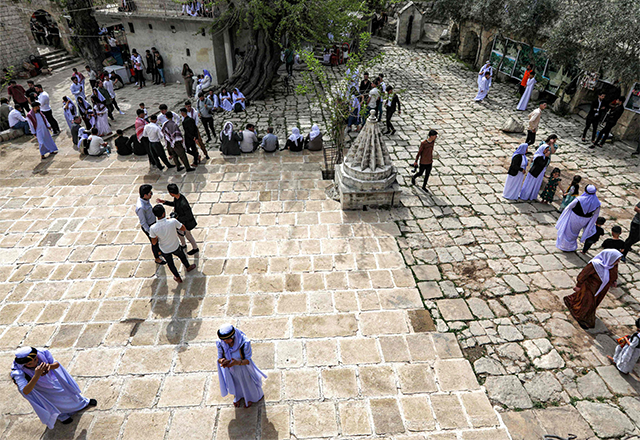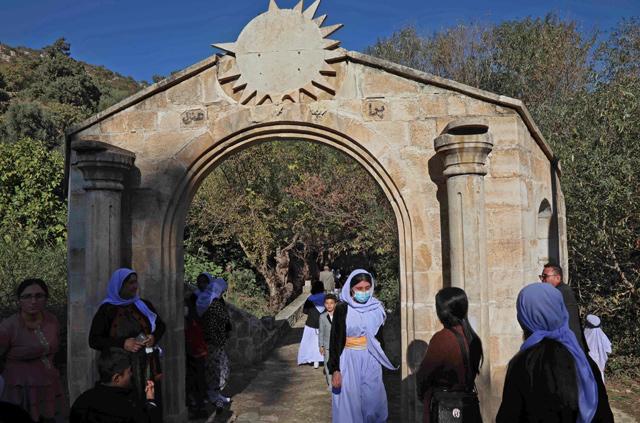You are here
Five years on, Yazidis remember brutal Daesh onslaught
By AFP - Aug 03,2019 - Last updated at Aug 05,2019

An Iraqi Yazidi woman visits the Temple of Lalish, in a valley near the Kurdish city of Dohuk, about 430km northwest of the Iraqi capital Baghdad, on Friday (AFP photo)
LALISH, Iraq — Iraq's Yazidi minority held its summer festival on the weekend, five years after extremists seized their ancestral heartland of Sinjar, in a brutal assault that still haunts the community.
On August 3, 2014, Daesh group fighters seized Mount Sinjar, and went on to slaughter thousands of Yazidi men and boys and abduct girls to be used as "sex slaves".
The United Nations has said Daesh’s actions could amount to genocide, and is investigating extremist atrocities across Iraq.
On Saturday, women wearing white T-shirts paraded around Lalish temple, the Yazidis' holiest shrine, brandishing banners to commemorate the "genocide" and portraits of Daesh victims.
They were led by Hazem Tahsin Bek, who late last month was enthroned as the community's prince at a ceremony in Lalish, succeeding his father Tahsin Said Ali who died in January after a long illness.
Yazidi dignitaries in long white robes took part in the ceremony during which participants lit candles and burned special oils as part of the annual ritual to purify the temple.
"The summer festival takes place at the same time as the commemoration of the genocide that took place in Sinjar when Daesh launched its assault against the mountain," Hazem Tahsin Bek told AFP.
The 56-year-old hereditary leader is in charge of running the community and cooperating with Kurdish authorities in the north and the federal government in Baghdad.
"We are remembering all those killed during this genocide five years ago," he said.
'Stability is crucial'
The UN special envoy to Iraq, Jeanine Hessni-Plasschaert, also paid tribute in a statement to "the suffering of the Yazidis on the fifth anniversary of ISIL's [Daesh’s] onslaught".
The envoy “lamented the current failure to bring about stability in the area”, adding that “stability is crucial for the stricken community to return home and rebuild its life”.
She urged Iraq’s federal authorities and those in the autonomous Kurdish region to “urgently find solutions that put the needs of the people first”.
Of the world’s 1.5 million Yazidis, around 550,000 were living in the remote corners of northern Iraq before 2014.
The brutal assault launched by Daesh in August that year pushed around 360,000 Yazidis to flee to other parts of Iraq, including the Kurdish region, where they live in ramshackle displacement camps.
According to authorities, more than 6,400 Yazidis were abducted by Daesh and only half of them were able to flee or be rescued, while the fate of the others remains unknown.
Another 100,000 fled abroad.
“I hope that something will be done for Sinjar. It is so devastated, as if it never existed,” said Alia Barkat, a young woman who took part in Saturday’s commemoration.
Barkat, who wore fashionable sunglasses and a white skirt, was among hundreds of people who thronged Lalish.
The shrine lies at the centre of the community’s other main hub in Iraq, in the Nineveh Plains, north of second city Mosul.
Five years after the onslaught, Sinjar, some 300 kilometres to the west, remains out of bounds for Yazidis.
Daesh destroyed the fields and the farming infrastructure which were the backbone of the minority’s livelihoods, while basic services have yet to be reestablished and reconstruction has been delayed.
The Yazidi cause has found a powerful symbol in Nadia Murad, a former Daesh abductee from Sinjar who escaped and went on to win the Nobel Peace Prize for her activism against sexual violence.
The Yazidi faith emerged in Iran more than 4,000 years ago and is rooted in Zoroastrianism, over time integrating elements of Islam and Christianity.
Related Articles
LALISH, Iraq — One by one, members of Iraq's minority Yazidi community light oil lamps to mark their New Year at a sacred shrine, but for Om
BAGHDAD — Hazem Tahsin Bek on Saturday succeeded his late father as prince of the Yazidi religious minority that was brutalised by the Daesh
LALISH, Iraq — Yazidis crowned a new spiritual leader on Wednesday at their holiest site of Lalish in northern Iraq, nearly two months
















